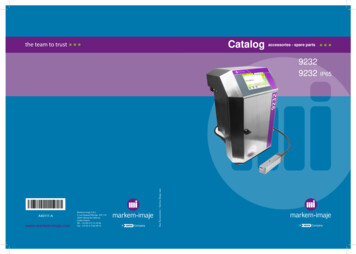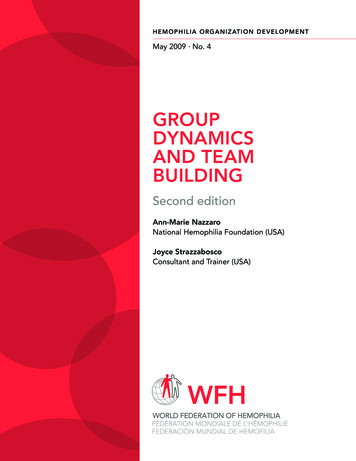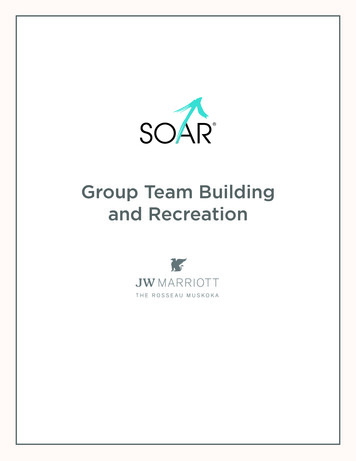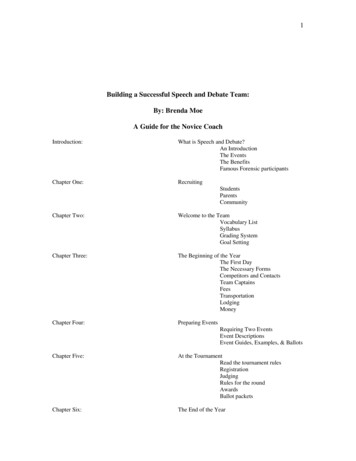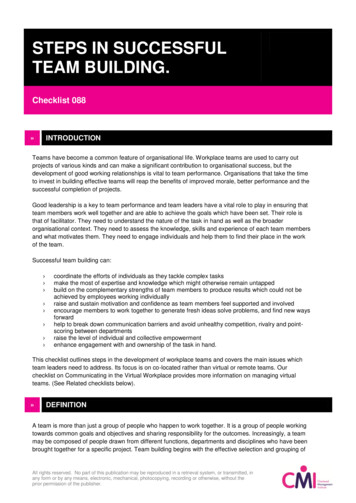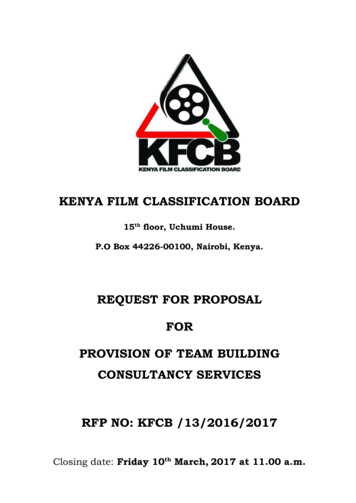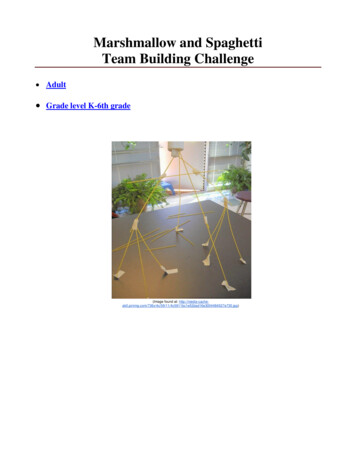
Transcription
Marshmallow and SpaghettiTeam Building Challenge Adult Grade level K-6th grade(Image found at: 911bc1e52dad16e3004484527e730.jpg)
Marshmallow/Spaghetti ChallengeGrade Level: K - 6th Set up as an online challenge for grade levels K - 6th hosted by Jen Wagner (www.projectsbyjen.com). Jen’s websitecontains creative projects for pre-K through grade siz. You can email Jen with questions at projectsbyjen@gmail.com Adapted from youtube idea from Peter Skillman (https://www.youtube.com/watch?v 1p5sBzMtB3Q)Materials per group: 20 pieces of spaghetti (dry) 1 meter of masking tape 1 meter piece of string 1 large marshmallow Scissors Flat tabletop or floor Timer (structure must be built within 18 minute time frame) Ruler or Measuring Tape to measure structure Camera to take pictures of finished structure (and during building process)Objective: To work as a team to build the tallest freestanding structure with a large marshmallow on top To identify the problem, analyze materials, brainstorm, build, and record resultsDirections: Divide students into teams of four (4) Talk with students about what they will be working on and that you will be measuring their structure from the bottomto the top of the marshmallow. Give time for questions from the students. Remind them that they do not need to useevery material. Explain that the structure must be free-standing (which means they cannot be touching it in anywaynor can it be leaning against anything) Some ideas say no tape on base - others have said that is fine. So, for this project -- we will allow tape to end of spaghetti & tabletop. Students may also break their spaghetti to form smaller pieces BUT they are limited to 20 full pieces of spaghetti atthe beginning of this project. Remind students that the ENTIRE marshmallow MUST be at the top of their structure. Marshmallow may not beused as an adhesive in any part of the structure. Explain to students that they have 18 minutes to construct their structure. Once students are in groups — repeat the instructions ask for any questions. Start the timer -- 18 minutes. Warn students at ten (10) minutes, five (5) minutes, two (2) minutes; using a displayedtimer is helpful (such as http://e.ggtimer.com) When the time is up — measure ALL structures Display the measurements and have a discussion on which were tallest, shortest, etc. If you wish, repeat this project on another day and then compare building techniques. pVTiAtyjWaYduLGaF-I2t0JCo/edit?usp sharingResources: Return of the Marshmallow Challenge: challenge/ Preschool Building YouTube: https://www.youtube.com/watch?v nKTzZdwETMY Marshmallow Challenge on Pinterest: enge/ Blogpost: mallow-challenge-day-2-activity.html?m 1 Marshmallow Challenge Website (written for adults): http://marshmallowchallenge.com/Instructions.html Blogpost w/ Pictures: nnual-marshmallow-challenge.html Build a Tower, Build a Team: arshmallow-challenge-buildtower.html
Building with Pasta: http://www.nasa.gov/pdf/544872main E3 SpaghettiAnyone C1.pdf TED2010 Tom Wujec Marshmallow Challenge Web Version.pdfStandards:This project meets the following ISTE Standards for Students: http://www.iste.org/docs/pdfs/20-14 ISTE StandardsS PDF.pdf1. Creativity and innovation: Students demonstrate creative thinking, construct knowledge, and develop innovativeproducts and processes using technology.a. Apply existing knowledge to generate new ideas, products, or processesb. Create original works as a means of personal or group expressionc. Use models and simulations to explore complex systems and issues2. Communication and collaboration: Students use digital media and environments to communicate and workcollaboratively, including at a distance, to support individual learning and contribute to the learning of others.a. Interact, collaborate, and publish with peers, experts, or others employing a variety of digital environments andmediab. Communicate information and ideas effectively to multiple audiences using a variety of media and formats4 Critical thinking, problem solving, and decision making: Students use critical thinking skills to plan and conductresearch, manage projects, solve problems, and make informed decisions using appropriate digital tools and resources.a. Identify and define authentic problems and significant questions for investigationb. Plan and manage activities to develop a solution or complete a projectc. Collect and analyze data to identify
Step One: Schedule a Meeting: Find 45-60 minutes when your team can fully engage in the challenge. I’ve runchallenges with groups containing as four people to as many as 800 people. Ensure thatyou have tables for each team.Step Two: Assemble a Kit for Each Team In advance of the meeting, create a marshmallow challenge kit for each team, with eachkit containing twenty sticks of spaghetti, one yard of masking tape, one yard of string andone marshmallow. These ingredients should be placed into a paper lunch bag, whichsimplifies distribution and hides the contents, maximizing the element of surprise. Spaghetti: Ensure that you use uncooked spaghetti. Avoid spaghettini as it is too thinand breaks easily. Fettucini is too thick. String: Include string that can be easily broken by hand. If the string is thick, includescissors in your kit. Marshmallow: Use a name brand or private label brand of marshmallows thatmeasure the ‘standard’ size, about an inch an a half across. Avoid mini or jumbomarshmallows. Also avoid stale marshmallows. You’ll want squishy marshmallowsthat give the impression of lightness. Masking Tape: Get standard masking tape. Generally, you’ll want to put the tape onthe side of the table, the back of a chair or a nearby wall. Rolling it in the bag tanglesthe tape. Paper Lunch Bags: Standard size lunch bags work well as do letter size ntation introducing the challengewill motivate the team. Let them knowthis challenge has been conducted by tensof thousands of people in every continent,from the CFOs of the Fortune 50 toStudents at all levels. The lessons learnedare universal.Goals & Rules: Be very clear about thegoals and rules of the challenge.Generally, you’ll want to repeat themthree times and reinforce them visually.Cheating: In almost every challenge,there is at least one team that will want tocheat or bend the rules in their favour.The clearer you are about the rules thebetter the results.Prizes: Offer a prize to the winning team.A standing ovation from the rest of thegroup is great. Books, software, perks even cash are also great incentives. Butbe wary of big prizes as you’ll read in theLessons of the Challenge.Music: Select the appropriate music forthe challenge. I prefer driving Rock orPop, but dramatic classical works welltoo.Tips: Start the countdown clock and the Also ensure that you have the following tools to run the challenge:music with the start of the challenge. Measuring Tape: Have a contractor’s retractable measuring available after thechallenge is finished so you can measure the height of the structures. Countdown Application or Stopwatch: The actual marshmallow challenge takeseighteen minutes. Eighteen minutes seems to be the magic time. Twenty minutes is too long and fifteen is tooshort. You can use a stopwatch, but better yet is to use a video projector and display the countdown time. 9/08/21/simple-countdown-timer-for-windows/. For a Mac, consider,http://www.baldgeeks.com/3-2-1.htm. Video Projector and Sound System (optional): For more impact, use a video projector to deliver theMarshmallow Challenge Presentation (or your own) and a sound system for music during the challenge. Time outa play list of exactly 18 minutes of music. You’ll want the challenge to end at the conclusion of the last song. Downloadacopy :TED2010 Tom Wujec Marshmallow Challenge Web Version.pdfStep Three: Deliver Clear Instructions Be clear about the goals and rules of the Marshmallow Challenge. Use the Acrobat Presentation to introduce thechallenge as well as to visually reinforce the instructions: Build the Tallest Freestanding Structure: The winning team is the one that has the tallest structure measuredfrom the table top surface to the top of the marshmallow. That means the structure cannot be suspended from ahigher structure, like a chair, ceiling or chandelier. The Entire Marshmallow Must be on Top: The entire marshmallow needs to be on the top of the structure.Cutting or eating part of the marshmallow disqualifies the team.
Use as Much or as Little of the Kit: The team can use as many or as few of the 20 spaghetti sticks, as much oras little of the string or tape. The team cannot use the paper bag as part of their structure. Break up the Spaghetti, String or Tape: Teams are free to break the spaghetti, cut up the tape and string tocreate new structures. The Challenge Lasts 18 minutes: Teams cannot hold on to the structure when the time runs out. Those touchingor supporting the structure at the end of the exercise will be disqualified. Ensure Everyone Understands the Rules: Don’t worry about repeating the rules too many times. Repeat themat least three times. Ask if anyone has any questions before starting.Step Four: Start the Challenge Start the countdown clock and the music with the start of the challenge. Walk around the Room: It’s amazing to see the development of the structures as well as notice the patterns ofinnovation most teams follow. Remind the Teams of the Time: Countdown the time. Usually, I call 12 minutes, 9 minutes (half-way through),7 minutes, 5 minutes, 3 minutes, 2 minutes, 1 minute, 30 seconds and a ten-second count down. Call Out How the Teams are Doing: Let the entire group know how teams are progressing. Call out each time ateam builds a standing structure. Build a friendly rivalry. Encourage people to look around. Don’t be afraid toraise the energy and the stakes. Remind the Teams that Holders will be Disqualified: Several teams will have the powerful desire to hold on totheir structure at the end. Usually because the marshmallow, which they just placed onto their structure momentsbefore, causing the structure to buckle. The winning structure needs to be stable.Step Five: Finish the Challenge After the clock runs out, ask everyone in the room to sit down so everyone can see the structures. Likely, just overhalf the teams will have standing structures. Measure the Structures: From the shortest standing structure to the tallest, measure and call out the heights. Ifyou’re documenting the challenge, have someone record the heights. Identify the Winning Team: Ensure they get a standing ovation and a prize (if you’ve offered one). Wrap up with the Lessons of the Marshmallow Challenge: Deliver the attached presentation or just describesome of the key lessons of the marshmallow challenge: Kids do Better than Business Students: On virtually every measure of innovation, kindergarteners create tallerand more interesting structures. Prototyping Matters: The reason kids do better than business school students is kids spend more time playingand prototyping. They naturally start with the marshmallow and stick in the sticks. The Business School studentsspend a vast amount of time planning, then executing on the plan, with almost no time to fix the design once theyput the marshmallow on top. The Marshmallow is a Metaphor for the Hidden Assumptions of a Project: The assumption in theMarshmallow Challenge is that marshmallows are light and fluffy and easily supported by the spaghetti sticks.When you actually try to build the structure, the marshmallows don’t seem so light. The lesson in themarshmallow challenge is that we need to identify the assumptions in our project - the real customer needs, thecost of the product, the duration of the service - and test them early and often. That’s the mechanism that leads toeffective tions.html
n.pdf Step Three: Deliver Clear Instructions Be clear about the goals and rules of the Marshmallow Challenge. Use the Acrobat Presentation to introduce the challenge
